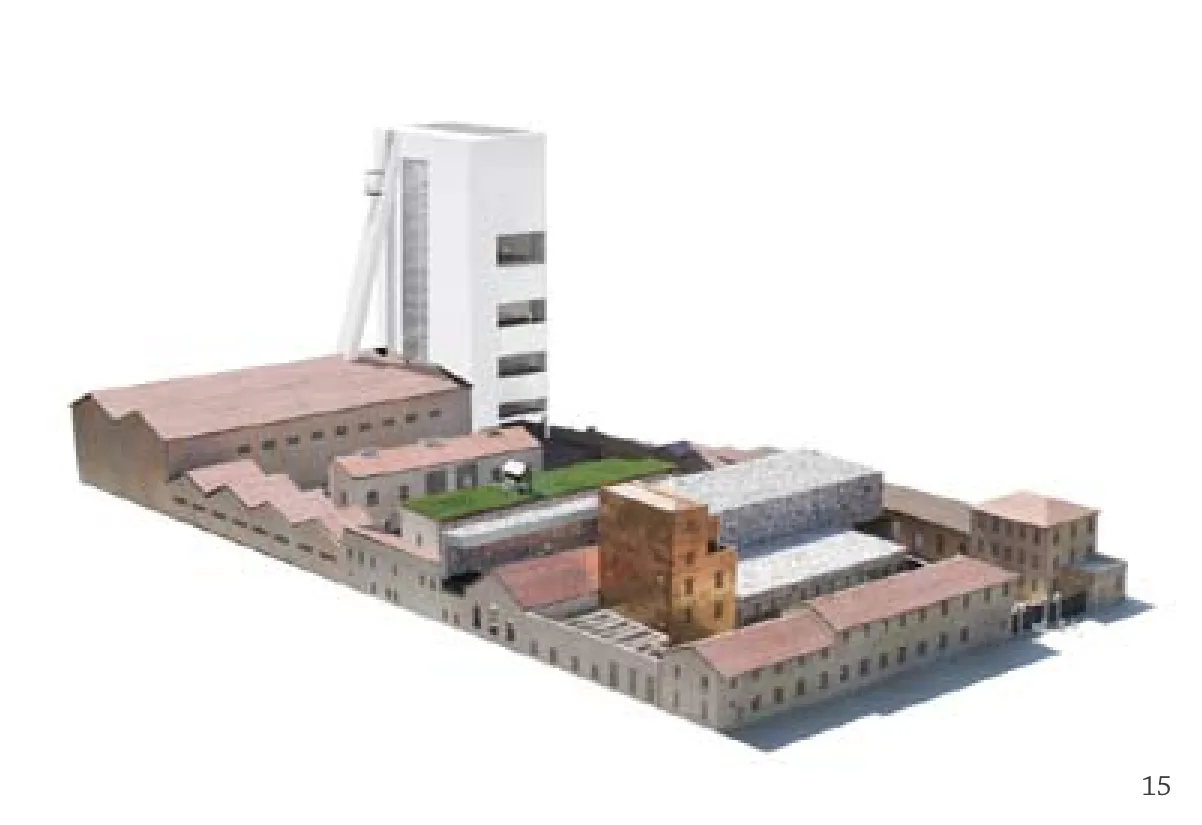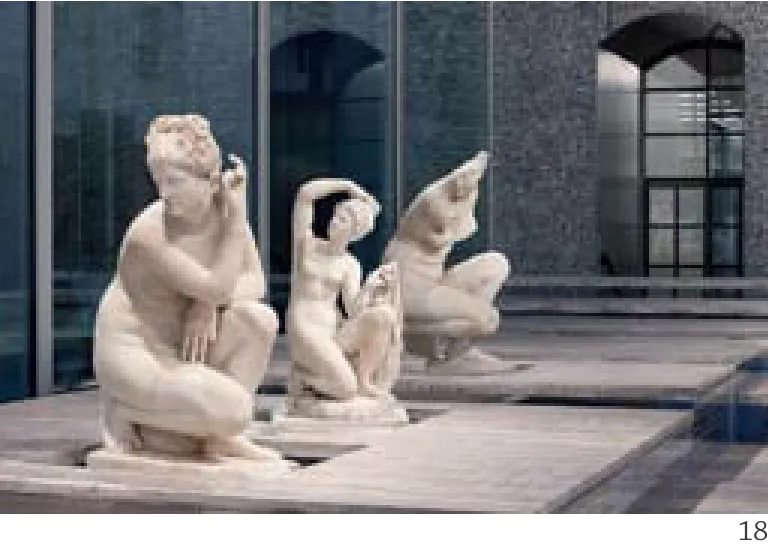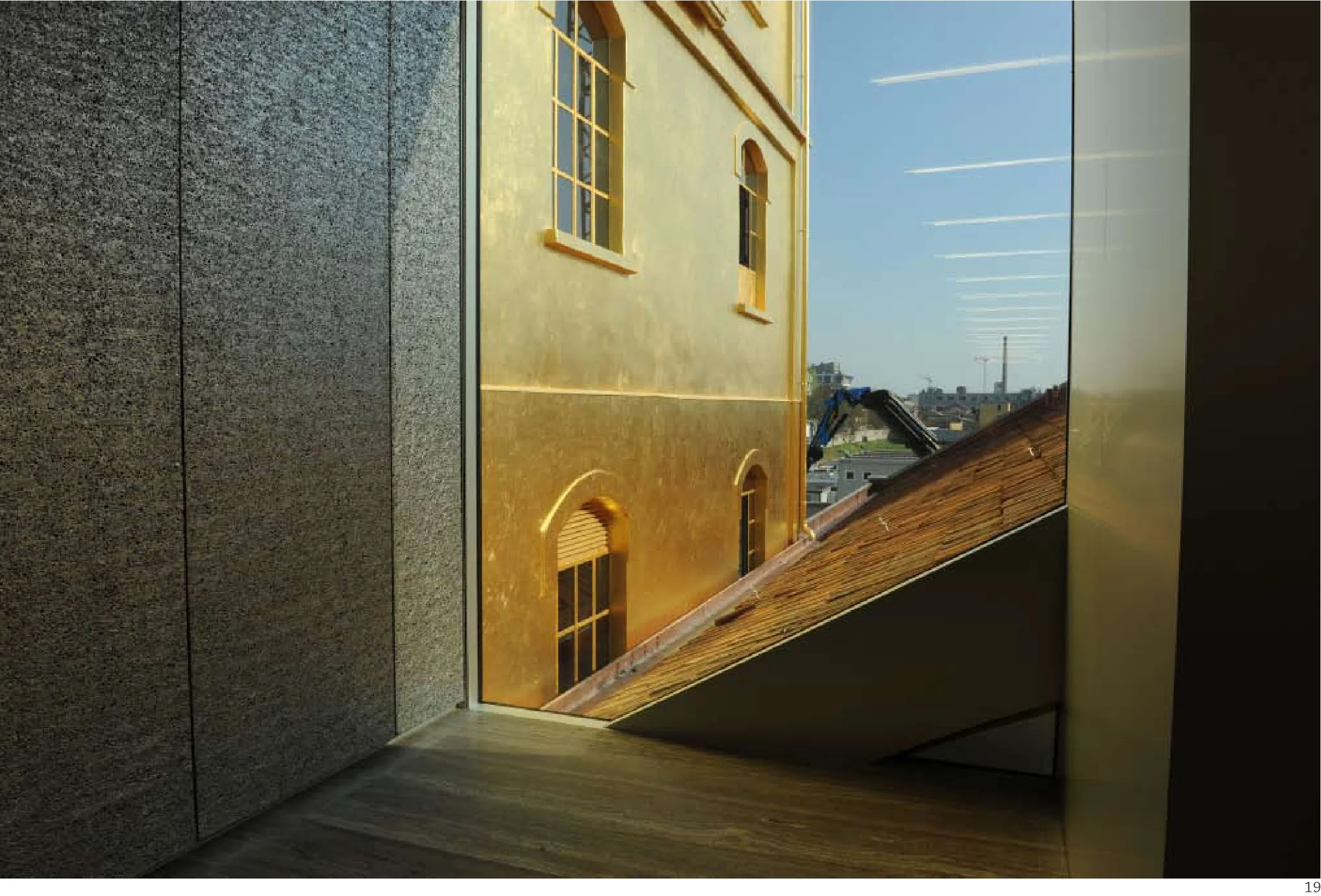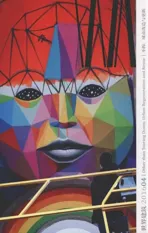普拉达基金会,米兰,意大利
2016-10-18建筑设计OMA建筑事务所
建筑设计:OMA建筑事务所
Architects: OMA
普拉达基金会,米兰,意大利
建筑设计:OMA建筑事务所
Architects: OMA

1.2外景/Exterior views

普拉达基金会的新总部位于米兰最南端的拉尔戈·伊萨尔科工业建筑园,其前身是一座建于1910年的杜松子酒厂。该建筑群由新建建筑和改造建筑共同组成。改造建筑包括仓库、实验室和筒仓,新建筑都布置在一个大中庭的两侧。
这座建筑群的改造模式聚焦于拓展艺术展陈空间的拓扑语汇。建筑群包括仓库、实验室、酿造筒仓等7幢现存建筑和3座新建筑——分别为Podium,一个临时展厅;Cinema,一座多媒体礼堂和Torre(塔楼)——用于展示基金会藏品和活动的9层常展空间。Torre目前还在施工中,未来将会对公众开放。
在拉尔戈·伊萨尔科工业园内留有两栋单体建筑:一座方正扁平,一座相对高耸。在经过仔细研究后,方形低矮建筑未能展现出吸引人的改造潜力,因而被拆除,从而扩大了厂区中庭的面积,使之成为了一个核心性的空间要素。而Deposito(仓库),这座位于园区西部的现存建筑则被巧妙地加以修改:建筑的地下空间担负了藏品储藏和展示的混合功能。空间被分隔成一些小室,供人们在其中近距离接触如“艺术家车队”这样的艺术作品。
位于大会堂东侧的单体建筑名为Cisterna(意为蓄水池)。建筑内部包含3个小房间,分别通过“诵经台”与外侧的阳台相连。这种空间格局明显旨在满足工业建筑的功能需求,如今却也沾染上了几分宗教的意味。
综合体中的Cinema是一个具有能动性的单元。其一侧的巨大双折叠门开启后,建筑室内就能与院子联通起来,成为一个半开敞空间。在其内部,阶梯式座位亦可变形为平地,使空间承担室外活动舞台或有顶的附加展览空间的职能。
中庭南部的4座小房子以及废弃的庭院如今用作基金会的办公室和长期展览厅。它们的限定圈内,矗立着“鬼屋”,一幢覆满金箔的保留建筑。其内部狭小的空间让一些要求特殊的艺术作品可以在家庭式的空间氛围中展出。
紧挨着的Podium 位于两条贯穿场地的通廊交点处,成为了整个建筑群的中心。这座新建建筑整合了两个风格迥异的体量:一个全玻璃幕墙的无柱底座空间和一个位于二层的被斑驳的泡沫铝外墙包裹着的体块。两个体块内部的空间格局相似,皆为多功能的临时展览大空间。
另一个主要的加建建筑位于厂区的西北角,是一幢9层高的塔楼。塔楼内容纳了场域艺术装置、一家餐厅、接待空间和会客设施。随着高度的变化,不同楼层给人们呈现出变幻的城市景观和特定的场域艺术装置。(张裕翔 译)
Located in a former gin distillery dating from 1910 in the Largo Isarco industrial complex on the southern edge of Milan, the new home of Fondazione prada is a coexistence of new and regenerated buildings including warehouses,laboratories and brewing silos, as well as new buildings surrounding a large courtyard.
The complex aims to expand the repertoire of spatial typologies in which art can be exhibited. The project consists of seven existing buildings, and three new structures: podium, a space for temporary exhibitions; Cinema, a multimedia auditorium; and Torre, a nine-story permanent exhibition space to house the foundation's collection and activities. Torre, currently undergoing construction work, will be open to the public at a later date.
Within the perimeter of the Largo Isarco complex existed two freestanding structures: one flat and square and the second more vertical. On close inspection, the square building did not offer attractive possibilities and was demolished,enabling the courtyard to become a significant element for open-air uses. The Deposito, an existing building on the west edge of the complex, is adapted for curatorial ingenuity: in its basement,the Fondazione's collection is arranged in a hybrid of strict storage and partial display, creating "chambers" where work such as a fleet of artists' cars can be unpacked or half opened to the public
The freestanding object to the east of the Great Hall, dubbed by the Cisterna, is divided in three rooms with three interior "pulpits" connected to an exterior balcony. Its configuration suggests a precise industrial need that now reads as a quasi-religious environment.
The Cinema acts as an autonomous cell within the compound. With large bi-fold doors,it can be instantly connected to the courtyard. Inside, the raked seating can be converted into a flat floor, allowing the space to be used for staging outdoor events, or as additional, covered gallery space.
Four "houses" that face the courtyard to the north and an abandoned garden to the south accommodate Fondazione offices and permanent galleries. Within their confines sits the "Haunted House", an existing building with its exterior covered entirely in gold leaf. Inside, the intimate scale of its interiors generates a "domestic" setting for specific works.
Adjacent, the podium forms the center of the compound, sitting at the intersection of the two perpendicular axes through the site. This addition combines two volumes of very different qualities: a fully glazed, column-free podium on the ground floor. Resting on the top is another gallery space cladded in aluminum foam, with a bubbled pattern. Both galleries provide large, multi-purpose areas for temporary exhibitions and events.
Another major addition to the complex is a nine-story tower in the north-west corner of the compound. The Tower houses site specific installations, as well as a restaurant, a reception space and guest facilities. The other floors, with gradually increasing heights, will accommodate site specific installations and provide alternating views of the compound and the city.

3-6外景/Exterior views
7总平面/Site plan
8地下一层平面/Floor -1 plan 9 首层平面/Floor 0 plan
10二层平面/Floor 1 plan

I-大会堂/Great HallII-装置/InstallationsIII-画廊、办公室/Gallery, officesIV-“鬼屋”/Haunted HouseV-普拉达藏品馆/prada ArchiveVI-卢娜·罗萨藏品馆/Luna Rossa Archive1-podium2-Cinema3-Torre


11轴测/Axonometric
12模型/Model
13.14剖面/Sections
项目信息/Credits and Data
主持合伙人/partners in Charge: Rem Koolhaas, Chris van Duijn
项目负责人/project Leader: Federico pompignoli
初步设计/preliminary Design: Sam Aitkenhead, Doug Allard, Andrea Bertassi, Aleksandr Bierig, Eva Dietrich, paul-Emmanuel Lambert, Jonah Gamblin, Stephen Hodgson,Takuya Hosokai, Jan Kroman, Jedidiah Lau, Francesco Marullo, Vincent McIlduff, Alexander Menke, Aoibheann Ni Mhearain, Sophie van Noten, Rocio paz Chavez, Jan pawlik,Christopher parlato, Ippolito pestellini Laparelli, Dirk peters, Andrea Sollazzo, Michaela Tonus, Jussi Vuori, Luca Vigliero, Mei-Lun Xue
最终方案/Final project: Anna Dzierzon, Jonah Gamblin,Hans Hammink, Ross Harrison, Matthew Jull, Vincent
Konate, Taiga Koponen, Vincent McIlduff, Andres Mendoza,Susanan Mondejar, Sasha Smolin, Michaela Tonus
施工图/Construction Documentation: Katarina Barunica,Marco Cimenti, Cecilia del pozo Rios, Anita Ernodi, Felix Fassbinder, peter Feldmann, Siliang Fu, Jonah Gamblin,Romina Grillo, Clive Hennessey, Taiga Koponen, Roy Lin,Debora Mateo, Vincent McIlduff, Andres Mendoza, Arminas Sadzevicius, Magdalena Stanescu, Lingxiao Zhang
施工管理/Construction Administration: Matteo Budel,Marco Cimenti, Andrea Giovenzana, Nicolas Lee, Victor pricop, pawel panfiluk, Caterina pedo', Stefano Tagliacarne,Luigi Fumagalli, Andrea Vergani, Nicola panzeri, Simone Bart
合作方/Collaborators
驻场建筑设计/Local Architect: Massimo Alvisi
执行建筑师/Executive Architects: Alvisi Kirimoto & partners, Atelier Verticale
结构工程师/Structural Engineers: Favero & Milan, SCE project
机电工程师/MEp Engineers: Favero & Milan, prisma Engineering
成本咨询/Cost Consultant: GAD
音响工程/Acoustic Engineer: Level Acoustics
透视图/Scenography: Ducks Sceno
消防工程师/Fire Engineer: GAE Engineering
项目/program: 公用面积/public Area: 12,300m2; 私人区域面积/private Area: 6600m2; 总建筑面积/Total Floor Area: 18,900m2
摄影/photos: Bas princen (fig.1-6,15,16),Charlie Koolhaas(fig.18)
评论
李晓峰:位于米兰南部工业园区的普拉达基金会新址,通过拆除与增建,完成了从废弃旧厂房向艺术展示空间的“脱胎换骨”。和许多类似项目一样,利用厂房空间的包容特性来打造艺术展示场所,是设计的主线。但OMA设计的这个保存与新建合成的项目,更注重利用这类空间环境的多样性,主要目标在于,拓展艺术展示空间类型的所有可能性。经过改造,原厂区内3个新建筑与7座旧建筑并存,相互独立又密切相关。可以看到,差异性和关联性并存于这个相对复杂多样的空间环境中。除了艺术陈列外,重塑后的丰富多样的建筑空间本身就是最重要的展品。建筑空间和艺术展示相辅相成,是普拉达基金会新址一大看点。
崔光海:废弃的工业园区和享有国际声誉的艺术画廊之间有多远的距离?这个项目告诉大家:只差一次神奇的改造设计。3个新建的建筑以独立的当代建筑姿态插入到原建筑群中,解决空间使用的完整性;新旧之间保持自身个性,旧建筑仅施以表皮重新涂装的轻微动作,这种微妙的平衡默默地注释了这个传奇品牌的历史并精确地把握住了这个活跃的当代艺术机构的性格。


15模型/Model
16.17外景/Exterior views
Comments
LI Xiaofeng: The new Fondazione prada, located in an industrial park in southern Milan, is completely "reborn" out of an abandoned factory building to become an art exhibition space through demolition and new construction. Like many similar projects, it is a principle line of design to create an art exhibition space by making use of the inclusive feature of the factory space. However, this project, designed by OMA,which combines conservation and new construction,pays more attention to utilizing the diversity of such a spatial environment. Its main aim is to explore all the possible types of art exhibition space.
After renovation, three new buildings and seven old buildings co-exist in the former factory, which are independent from each other but closely related as well. It can be seen that difference and relevance exist simultaneously in this relatively complex and diverse spatial environment. In addition to art exhibition, the rich and varied architectural space after renovation,in itself, is the most important exhibit. The way that architectural space and art exhibition complement each other is a highlight of the new Fondazione prada.
CUI Guanghai: How far is it from an abandoned industrial park to an internationally renowned art gallery? This project tells us: the distance can just be a magical renovation design. Three new buildings, with a gesture of independent contemporary architecture, are added to the existing building complex, which keeps the integrity of the space use. Both new buildings and old buildings maintain their own characters, with old buildings just being slightly renovated through recoating the surface. Such a delicate balance not only silently interprets the history of this legendary brand,but also accurately grasps the nature of this active contemporary art institution.


18古典系列展品/Serial Classic
19由窗口望向“鬼屋”/Haunted house from window
Fondazione prada, Milan, Italy
